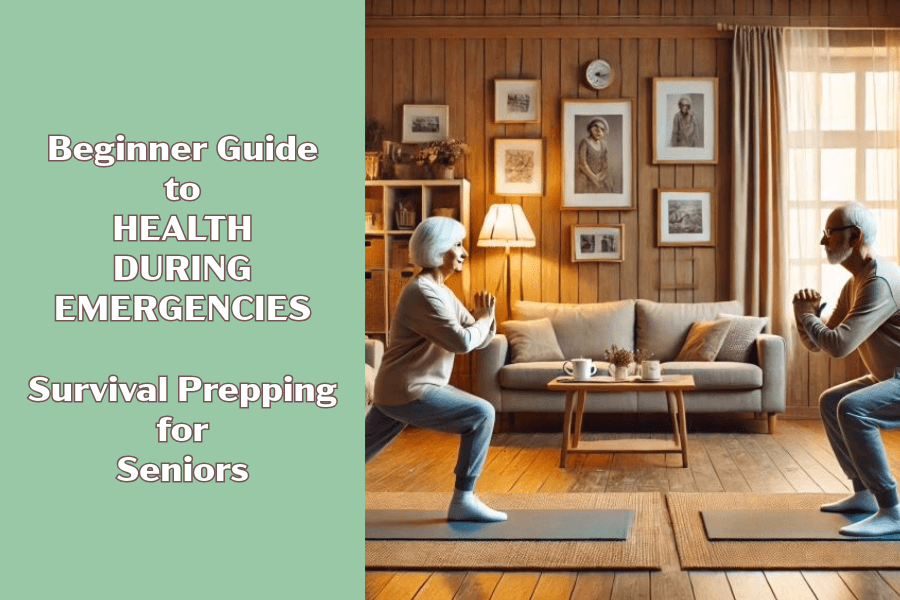Beginner Guides: Health During Emergencies
Physical and mental health often take a back seat in emergencies, but staying active is essential. Regular physical activity isn’t just about keeping fit; it helps manage stress, too. Even in limited spaces, adapting your exercise routines matters. Think of simple activities you can do with minimal equipment, like bodyweight exercises, stretches, or even a brisk walk around your living space.
I live on five acres, which we purchased in 2007 for my horse and two dogs. We built a big barn for her that withstands 150mph winds. Sadly, my mare, Rocki, passed in 2020. I replaced her with a huge Anatolian Pyrenees (Anatolian Sheperd x Great Pyrenees,named Emma).
My dog and I walk together around the pastures left from when I had my horse. I also have a treadmill, an inversion table, and a recumbent bike in my bedroom. That doesn’t mean I use all of them regularly, lol. Currently, a bunch of survival items are stacked on my treadmill. I prefer the recumbent bike and inversion table.
Managing anxiety is crucial when you’re surrounded by chaos. Simple mindfulness exercises like deep breathing or progressive muscle relaxation can do wonders. These techniques help keep panic at bay and maintain a semblance of calm. Find what works best for you and incorporate it into your daily routine.
In tough times, social connections are more important than ever. Using communication tools like phones and tablets can help maintain those bonds. Technology offers a bridge to reach out and stay connected with family and friends. These connections provide essential support, reducing stress and improving mental well-being.
Read & Learn: Emergency Communication Survival Gear
Building a support system isn’t just beneficial; it’s vital. Social support reduces stress and promotes mental well-being during challenging times. Whether it’s family, friends, or community groups, having a network you can lean on makes all the difference. Prioritize these connections and maintain regular communication.
Balancing physical activity, managing stress, and nurturing social bonds can bolster health during emergencies. These practices enhance resilience, helping individuals weather the storm with more stability and less anxiety.
Mental Health in Emergencies: Key Facts and Insights
When emergencies strike, nearly everyone experiences some level of psychological distress. It’s normal to feel overwhelmed, but it’s essential to understand that these feelings are often temporary. With time, most people find their footing again. Yet knowing this doesn’t make it more accessible now, so awareness is vital.
Disturbingly, around 22% of individuals affected by conflict or war in the last decade have struggled with mental health disorders. These aren’t just numbers; they represent real lives disrupted by trauma. Addressing these disorders promptly can alleviate suffering and restore a sense of normalcy.
Especially vulnerable are those with severe mental disorders. During crises, access to necessary mental health services becomes a lifeline. Ensuring these individuals receive the support they need is crucial for their well-being.
Guidelines and services often outline a multi-level support system to address these challenges. From basic services to more clinical care, these steps ensure that urgent mental health needs are met swiftly. Comprehensive support doesn’t just aid individuals; it strengthens communities, too.
Emergencies might be chaotic, but they also offer a silver lining. They present a chance to establish or improve sustainable mental health systems. By leveraging the urgency of the times, communities and authorities can build better frameworks for mental health care that last well beyond the immediate crisis.
Enhancing Mental and Behavioral Health Protocols
Preparedness is the cornerstone of resilience. Being prepared can make a significant difference when a crisis hits, whether it’s you, your family, or your community. Building individual and communal resilience involves understanding potential mental health challenges and having strategies to confront them.
Read & Learn: How to Survive Off-Grid: A Guide to Homestead Living
When emergencies unfold, identifying mental health needs is the starting point. Temporary distress or more serious post-disaster psychiatric conditions require attention. But knowing what you’re dealing with is just one part of the equation; responding appropriately is the next crucial step.
A range of interventions can prove helpful.
- Psychological First Aid, for instance, provides immediate emotional support to those affected, helping to calm and comfort them.
- Crisis Counseling
- and Psychological Debriefing offer structured ways to constructively process the events and emotions tied to the crisis, channeling distress.
Sometimes, the situation demands specialized mental health services. Triage becomes essential here, directing individuals to suitable resources and referrals. A clear pathway to additional help ensures no one falls through the cracks.
Implementing these protocols and interventions requires a collaborative effort involving:
- mental health professionals,
- community leaders,
- and emergency responders.
Together, they craft a safety net to support every individual in need, ensuring that mental and behavioral health considerations are at the forefront of emergency response.
Addressing Diverse Populations: Customizing Support
Emergencies don’t affect everyone in the same way. Different groups have unique needs that demand tailored support. Recognizing these differences is vital for practical assistance.
First responders often face intense pressure and require specific mental health support. It’s about ensuring they have the resources to manage their stress and continue providing critical services.
Cultural differences and access issues might challenge tribal communities, farmers, and farmworkers. Customized approaches that respect traditions and address specific hurdles are necessary here.
Older adults, children, and teenagers deserve special attention, too. Their vulnerability means that support systems must be age-appropriate, providing care and understanding suited to their needs.
People with disabilities or pre-existing mental health conditions and those with limited English proficiency often find barriers to getting help. Removing these barriers through accessible services and language support is a crucial step.
Read & Learn: Basic Sign Language Vocabulary Every Senior Should Know
Communities of color, those living in poverty, refugees, and migrants face unique hurdles. Tailored strategies considering:
- social,
- economic,
- and cultural factors
- can greatly affect how these groups recover and rebuild.
Ultimately, addressing diverse populations means shaping our responses to fit. It’s about being inclusive, understanding, and responsive to the varied needs of all individuals during emergencies.
Recovery: Navigating Resources and Support Systems
Recovery from emergencies is a journey; having the right resources makes all the difference. Knowing what’s available is crucial so you’re not just weathering the storm but rebuilding stronger.
The Disaster Technical Assistance Center (DTAC) offers pivotal support and information, equipping communities with strategies to handle mental health challenges during crises. Their guidance can be a real game-changer in how effectively regions respond.
Hotlines like the Disaster Distress Helpline offer immediate support to those struggling with emotional distress. Knowing someone on the other end is ready to listen and help can provide immense comfort.
Publications like ‘Mental Health and Our Changing Climate‘ (PDF) shed light on the impacts and inequities that arise during such times. These resources help tailor responses to be equitable and practical, ensuring everyone gets the support they need.
Cultural awareness is vital, especially in diverse settings. Tips for disaster responders working in areas like Indian Country emphasize understanding and respecting cultural nuances, leading to more meaningful aid.

By leveraging these resources, communities can improve their response efforts and ensure robust support systems are accessible to all. This proactive approach not only aids recovery but also fortifies resilience for future challenges.
Risk Factors & Warning Signs: Preventive Measures
Prevention is also vital when addressing mental health challenges during emergencies. Recognizing early warning signs of emotional distress can lead to timely interventions, which is crucial for effective support.
It’s important to be aware of the risk factors that might exacerbate mental health issues in specific communities. Risk factors can range from existing mental health conditions to the unique stressors that affect vulnerable populations, like economic hardship or social isolation.
Proactive steps can be taken to mitigate these risks. These might involve:
- enhancing community outreach,
- providing mental health education,
- fostering open communication channels,
- and encouraging individuals to seek help without stigma.
Strengthening community collaboration is essential. By working together, communities can develop comprehensive mental health strategies and ensure that no one falls through the cracks during challenging times.
Building awareness and understanding within communities about mental health can significantly reduce the stigma, ensuring more individuals feel comfortable seeking the help they need.
Building a Resilient Future: Long-term Strategies
Creating a resilient future hinges on strong, enduring mental health systems. These systems are about responding to emergencies and preparing for them before they arise.
Policy changes can improve how we respond to mental health needs during crises. Advocating for policies that prioritize mental health services and resources is crucial. It ensures that communities have the support they need when facing adversities.
Holistic strategies are essential to constant community engagement and resilience building. This involves integrating mental health education into regular community programs, ensuring awareness and preparedness are part of everyday life.
Education and awareness campaigns can equip individuals with tools to manage stress and promote well-being, which makes a lasting difference. Encouraging conversations around mental health normalizes the topic, making seeking help a communal and supported action.
The goal is to create communities that are reactive and proactive in their approach. Building resilience ensures that communities survive, thrive, and emerge stronger when challenges come.

